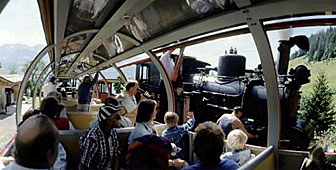Romantic age of steam alive and well in Brienz

Although there are all sorts of ways of getting up into the mountains nowadays, including sophisticated cable cars which can carry over 200 people, the town of Brienz prefers to stick with traditional methods. The Brienz Rothorn Railway still uses steam locomotives, just as it did when it was first built.
During the 19th century alpine tourism was enjoying its first success, and many communities were looking at ways of attracting visitors.
The people of Brienz watched a mountain railway being built up the Rigi in central Switzerland, and realized it might take visitors away from their own town. So they decided on an ambitious plan; a cog railway from the town of Brienz all the way up to the 2,350 metre summit of the Rothorn.
Work was begun in 1889, and at any one time during construction over 600 Italian builders toiled on the line. A report from that time describes the atmosphere as the work went ahead: “Now there was a great hustle and bustle on the mountain and everywhere above and below, on the rocks and along the gravel slopes, men started to work. Feeding them was no easy task, and there was even a shortage of hospital beds for the injured.”
Opened in 1892
Despite these difficulties, the railway was completed in record time, and officially opened in 1892. It was a success from the start; visitors loved the breathtaking journey up to the Rothorn. And although the railway fell on hard times during the two world wars, it is still a success today.
“People love the old engines,” says Christa Anderegg of the railway’s marketing department. “It’s a real experience travelling on the Rothorn railway, you can smell the steam, and touch the locomotive – there’s something going on throughout the entire trip.”
Nowadays the railway has eight steam locomotives, and several more modern diesel engines. Not surprisingly, most passengers try to book their place on one of the steam trains. I was welcomed by conductor Pia Zumbrunn into the guard’s cab, which unusually, is at the front of the train. The steam engine is at the back to push the carriages up to the summit.
“I love my job,” says Zumbrunn. “I’m out in the mountains every day, I take the tickets and help the passengers, and I stand here at the front to check the line. I’m the eyes of the driver.”
Shooing away cows
Zumbrunn also has some more unexpected duties; if there are cows on the line she has to sound a warning, and then climb out of her cab to shoo them away. And, when the train stops at the halfway station of Planalp, it is Zumbrunn’s job to refill the engine with water.
Driver Michael Thoeni normally finds himself surrounded by eager passengers, all keen to have a closer look at the locomotive.
“Steam engines are much better than diesel engines,” says Thoeni. “Although, they are harder work too. There’s just something about steam, it’s romantic; the sound of it and the rhythm of it, it’s just nicer.”
The Brienz Rothorn Railway has set up weeklong steam workshops for diehard steam fans whose enthusiasm is not satisfied by the hour-long journey up the mountain.
“These are really great weeks,” says Christa Anderegg. “First the participants spend a few hours learning the technical details of the steam engines, and then for the rest of the week they are working on the locomotives themselves. It’s great to see them coming back in the evening; they are always tired, but full of smiles.”
But the journey up the Rothorn is not only worthwhile for lovers of steam engines. “The scenery on this trip is beautiful,” says Pia Zumbrunn. “We see forests, and waterfalls, and, well, once we get higher, there’s no more need for words.”
Alpine flowers
Zumbrunn is right. As the train passes the tree line, the once chattering passengers fall silent; they are quite simply speechless with wonder at the views. The alpine pastures are thick with flowers; gentian, monks hood, ladies mantle and alpine roses line the track. Far below, Lake Brienz sparkles turquoise in the sunshine, while above, range after range of mountains is revealed.
To get the full panorama, there is a short walk to the summit of the Rothorn from the top station. Once at the top, there is a 360-degree view, from the peaks of the Eiger, Mönch and Jungfrau on one side, to the Pilatus and the Titlis on the other. On a clear day you can see beyond Lake Brienz to Lake Thun, and even as far as the Black Forest in Germany.
There are a number of beautiful hiking trails from the top of the Rothorn, most of them quite strenuous. You can even take the trail back down to Brienz itself, a hike of about five hours.
But, with those friendly steam engines waiting for passengers at the top station, why exert yourself? The views are just as spectacular, and the journey just as interesting on the way down, as it was on the way up.
by Imogen Foulkes

In compliance with the JTI standards
More: SWI swissinfo.ch certified by the Journalism Trust Initiative
You can find an overview of ongoing debates with our journalists here. Please join us!
If you want to start a conversation about a topic raised in this article or want to report factual errors, email us at english@swissinfo.ch.